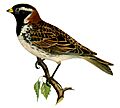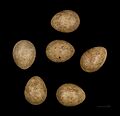Lapland longspur facts for kids
Quick facts for kids Lapland longspur |
|
|---|---|
 |
|
| Male | |
| Conservation status | |
| Scientific classification | |
| Genus: |
Calcarius
|
| Species: |
lapponicus
|
 |
|
| Synonyms | |
|
Fringilla lapponica Linnaeus, 1758 |
|
The Lapland longspur (Calcarius lapponicus), also called the Lapland bunting, is a small bird known for its long claws. It belongs to the longspur family, Calcariidae. This group of birds is now considered separate from the finch family.
Contents
What's in a Name?
The English name "longspur" comes from the bird's unusually long claws on its back toes. The scientific name Calcarius comes from a Latin word meaning "spurs." The second part, lapponicus, refers to Lapland, a region in northern Europe.
Appearance of the Lapland Longspur
The Lapland longspur is a strong bird with a thick, yellow beak, perfect for eating seeds.
- Summer Male: During summer, the male has a black head and throat. It has a white stripe above its eye and a chestnut-colored patch on the back of its neck. Its belly is white, and its back is streaked with black and grey.
- Other Birds: Females and young birds have a plainer, orange-brown head. Their backs are browner, and they still have chestnut patches on their neck and wings.
Measurements:
- Length: About 15-16 cm (5.9-6.3 inches)
- Weight: Around 22-33 grams (0.8-1.2 ounces)
- Wingspan: About 22-29 cm (8.7-11.4 inches)
Where They Live and Travel
Lapland longspurs breed in the Arctic regions of Europe, Asia, Canada, and the northernmost United States.
These birds are migratory. This means they travel long distances. They spend their winters in places like the Russian steppes, the southern United States, and coastal areas of southern Sweden, Denmark, and Great Britain. The Lapland longspur is the only longspur species found in Asia. Scientists believe it has lived in Eastern Europe for at least 30,000 years.
Lapland Longspur Behaviour
Bird Calls
The most common sound you'll hear from a Lapland longspur in flight is a harsh "prrrrt." This sound is usually followed by a more nasal "teeww." When they are breeding, they make a softer "duyyeee" followed by a pause and then a "triiiuuu." These two sounds often switch back and forth.
Reproduction and Nesting
Lapland longspurs build their nests on the ground. They prefer wet areas with birch or willow trees, or bare mountains. In winter, they often gather in mixed groups with other birds. They like to feed near the tree line. Females usually lay 2 to 4 eggs.
What Do They Eat?

The diet of the Lapland longspur changes with the seasons. In winter, they mostly eat seeds. In summer, when insects are active, they switch to eating arthropods (like insects and spiders).
During winter, longspurs search for seeds on the ground. They rarely eat seeds directly from plants. They might forage in one spot for a few minutes to an hour before flying off to find a new feeding area. Their winter diet mainly includes seeds from different types of grass, millet, and wheat.
When the breeding season arrives, the birds fly north. Their diet then changes to arthropods. Young birds are fed only arthropods. Adult birds also eat arthropods during this time (June to July). These birds often catch insects in mid-air. However, they will also search through plants if the weather prevents insects from flying. Longspurs can eat a lot! They might consume between 3,000 and 10,000 insects or seeds each day. This number can increase by another 3,000 when they are feeding their young. Fly larvae and adult flies make up a large part of their insect diet.
Images for kids






